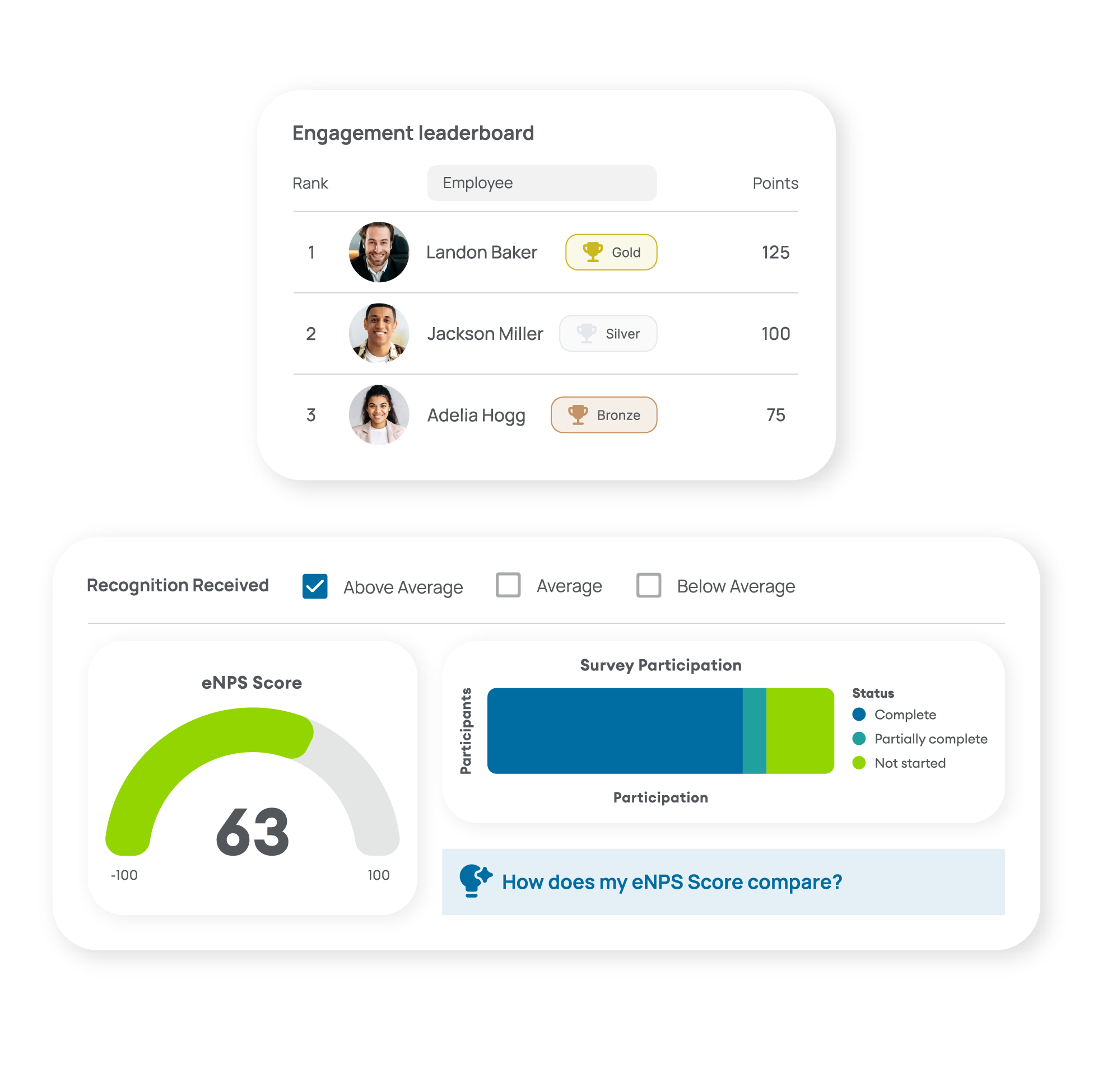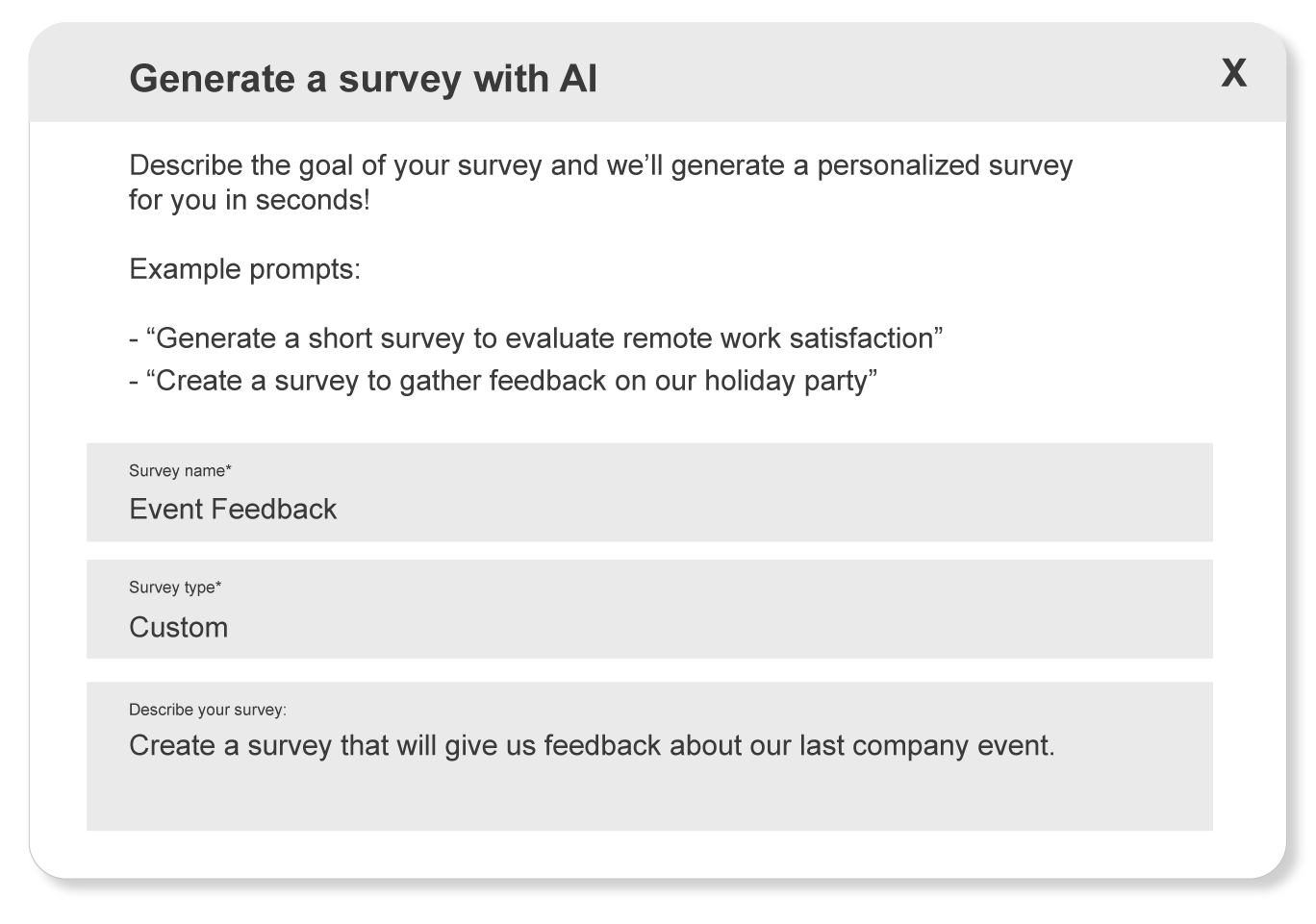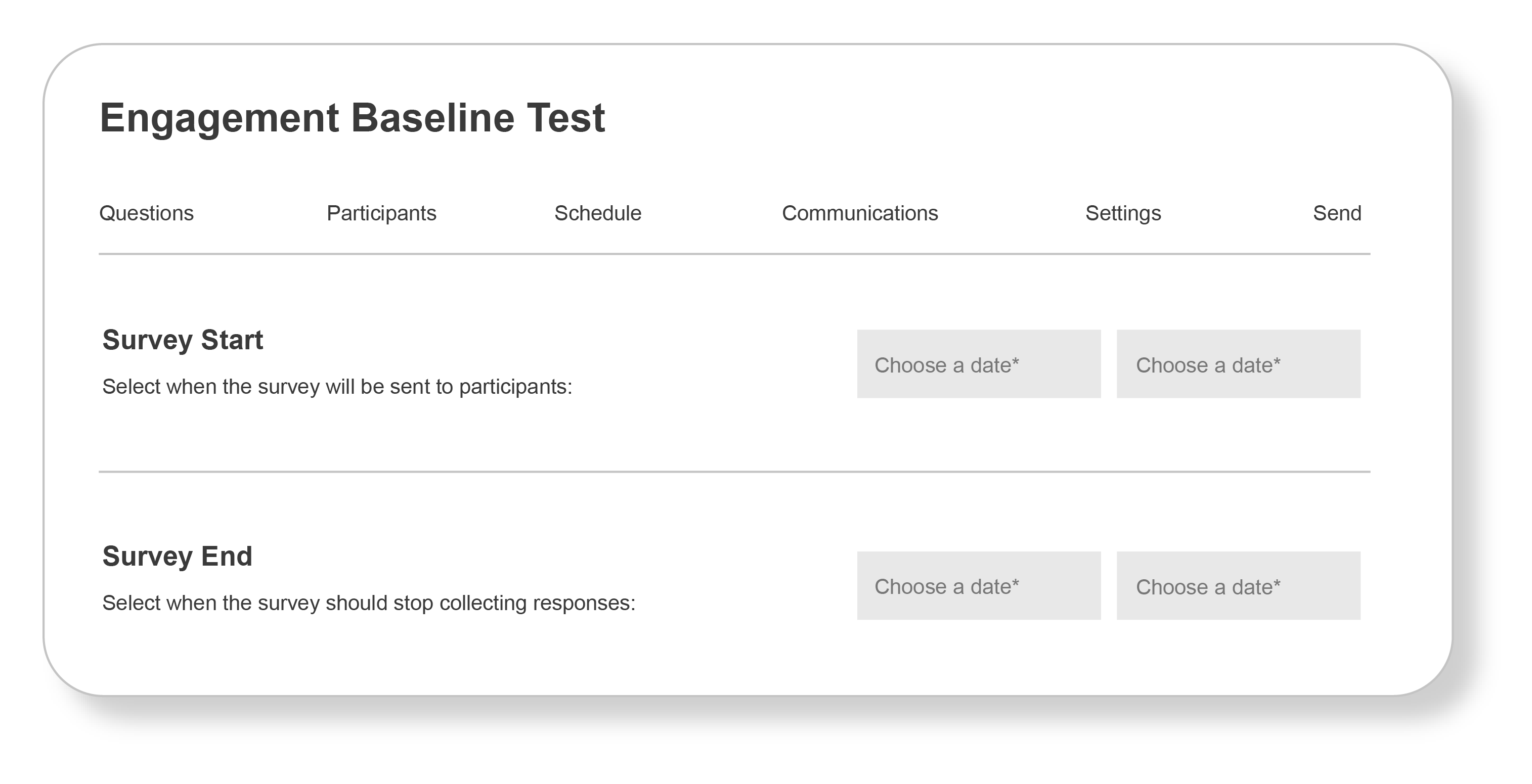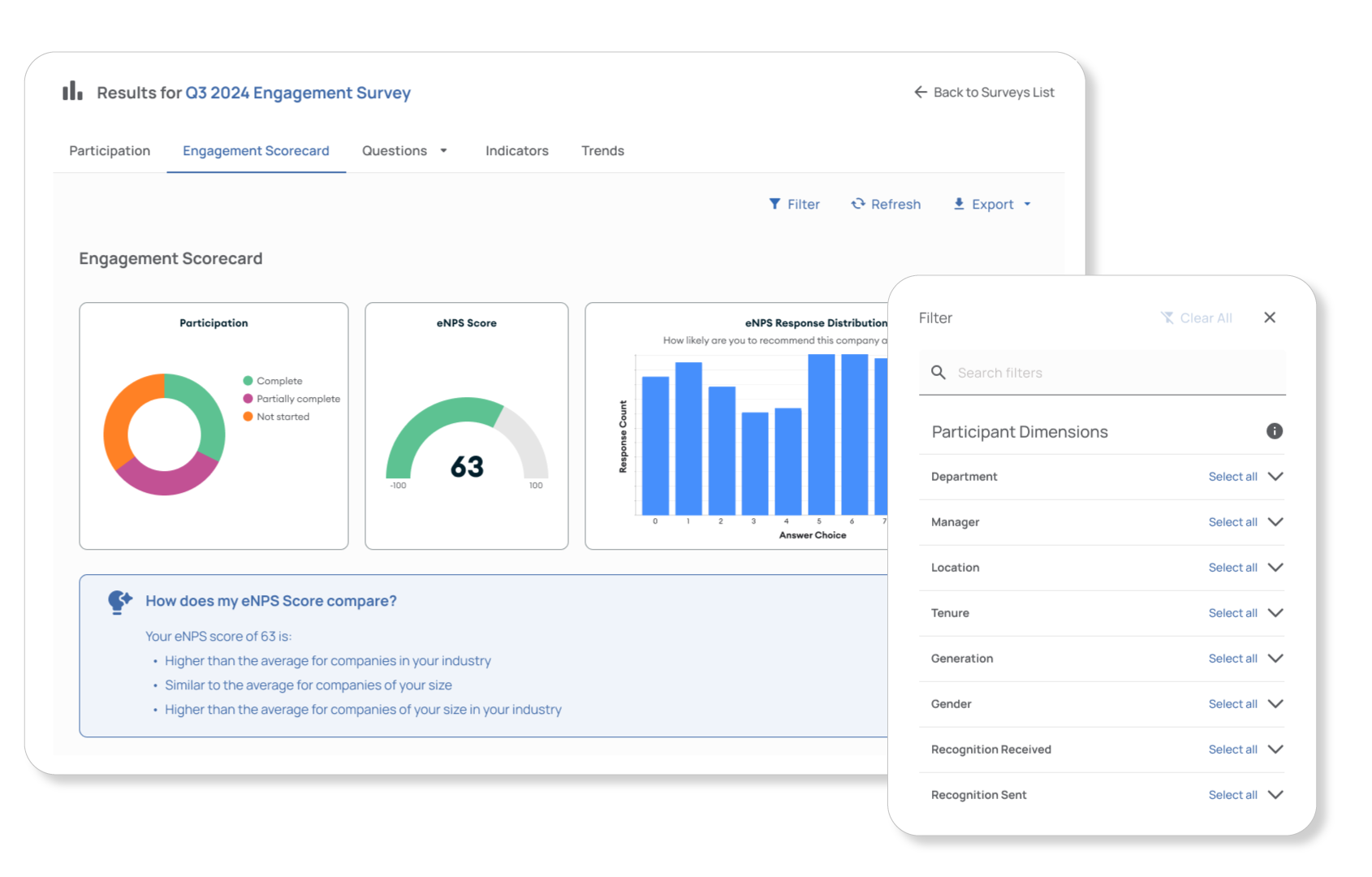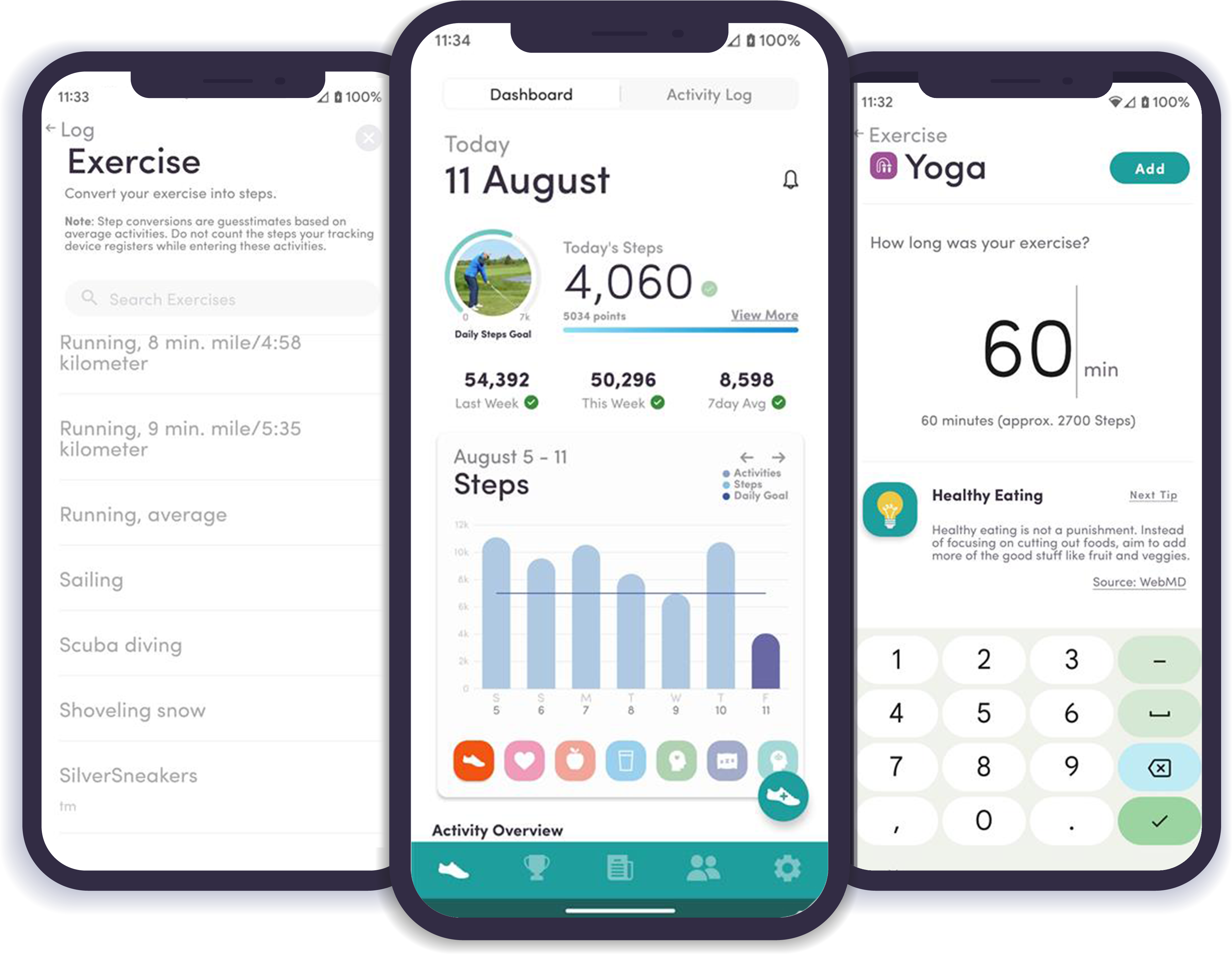May 30, 2025

Many businesses treat the employee Net Promoter Score (eNPS) as their north star for retention—just like NPS is for customers. The logic is the same: “Detractors” give you low scores and are at high risk of churn. That’s why employee listening tools—used to measure things like eNPS—often get lumped in with “employee retention tools.”
We’re not here to contest the importance of measuring and tracking eNPS—it’s a vital indicator of employee retention. But if you’re looking to build a comprehensive retention strategy—one that identifies factors impacting it and helps you actively fight attrition—you’ll also need to:
- Look beyond eNPS. While eNPS helps track retention, it doesn’t reveal why some groups are churn risks or the factors contributing to retention. Our research shows that six factors—belonging, leadership, equity, purpose, empowerment, and wellbeing—predict employee engagement, and ultimately, retention.
- Realize that employee listening is the starting point, not the whole strategy. Surveying lets you measure employee engagement and uncover groups more likely to churn, but you’ll only improve retention by taking action—which requires different tools.
For example, if your top performers score low on eNPS and feel burned out, you’d consider launching an employee wellness program. If some teams are at risk of churning because they don’t feel recognized by leadership, you’d need to invest in a recognition program. Launching these engagement programs requires the right tools.
This guide explains how to develop a retention strategy from end to end using employee retention tools. We cover five categories of tools—employee listening, recognition and rewards, wellness, learning and development, and performance management.
Trusted by over 40,000 companies worldwide, including Unilever, Ford, and Jaguar, Terryberry’s integrated employee engagement platform lets you develop data-driven retention strategies, take action, and measure the impact of your initiatives. Schedule a demo to discover how Terryberry can support your retention strategy.
1. Employee Listening Tools: Uncover Attrition Risks and the Factors Impacting Retention
Employee listening tools are essential for companies moving beyond sporadic, small-scale employee surveys to developing a dedicated employee engagement program. They automate the tedious parts of designing and running surveys, such as choosing the right types and questions, making surveys readily available on the right channels, and analyzing responses.
To run an organization-wide employee engagement program that drives results, you’ll need to design and run surveys for different scenarios, interpret the findings, take action, and measure results. This means regularly running various types of surveys—like burnout, employee satisfaction, and exit—on various groups across different channels.
Most mainstream employee listening tools offer similar core capabilities, such as survey design, scheduling, and integrations. Many vendors incorporate various surveying tools in their product suite, such as voice of customer (VoC) tools for collecting customer feedback, or product research tools.
Unlike these vendors, Terryberry’s product suite is focused exclusively on employee engagement. That’s why our product suite includes employee listening, recognition and rewards, and employee wellness tools, instead of customer or product feedback tools. Companies use our employee listening tool to measure beyond eNPS and collect insights on the factors affecting retention.
Read on to learn how Terryberry’s employee listening tool informs impactful retention strategies. We also discuss some popular, standalone surveying tools, including SurveyMonkey and Qualtrics.
Terryberry
Terryberry’s employee listening software streamlines the process of creating, running, and interpreting employee engagement surveys. You can track eNPS with surveys, uncover deeper retention insights by measuring engagement indicators, and use situation-specific surveys to capture niche insights. For example, running exit surveys to understand why someone’s leaving, or burnout surveys to uncover the causes of stress in specific teams.
To really understand why some people are leaving your organization, and what’s motivating others to stay, we developed a science-backed culture model with six engagement indicators with the help of 3 independent academic researchers.

These six indicators—belonging, leadership, equity, purpose, empowerment, and wellbeing—predict employee engagement and retention. Our engagement baseline survey, backed by I/O psychologists, measures engagement across these indicators using 38 questions. The survey assesses factors impacting retention and your team’s engagement, both positively and negatively, by attributing scores to each indicator.
For example, maybe one team with low retention gets a score of -3 for leadership, indicating that people don’t stick around because they feel disconnected from leadership. Maybe another department, with a high eNPS score, gets a +20 score in belonging, indicating that people are well-integrated into your company culture.
This data helps you identify exactly which factors to address to improve employee engagement across your organization or within specific teams.
Terryberry’s survey library contains dozens of ready-made surveys to capture insights around employee satisfaction, retention, and employee engagement. For retention specifically, businesses use a combination of eNPS, baseline surveys, and sometimes targeted exit surveys.
Need a niche survey that’s not included in the library? Just describe your goals to Terryberry’s AI helper. The AI creates a custom survey with questions from Terryberry’s library as a foundation.
For example, maybe you want to learn how a new change is impacting a specific engagement indicator—e.g., how a specific department is responding to a new leader, or if your team-building exercises have been increasing a sense of belonging.
After you’ve chosen which survey(s) to run, Terryberry’s team works with you to maximize participation by building out communications for the survey—including initial messages, reminders, and follow-ups. We distribute the surveys on channels your teams use the most, whether that’s Teams, email, or non-digital.
With Terryberry’s employee listening tool, you can schedule surveys—plus follow-ups and drill-downs—in advance:
Based on the findings from your initial employee retention surveys, you’ve taken steps to improve retention. Maybe this includes broad, organization-wide initiatives, or tailored programs to address a specific engagement indicator in one department.
The analytics and indicators dashboards display retention metrics and other relevant metrics, including eNPS, engagement indicator scores, Likert scores, participant breakdowns, and tailored recommendations on where to focus next.
For example, after you run the baseline survey, the indicator dashboard displays six scores for each indicator. Maybe one department scores 10 in leadership but -2 in equity. In this case, you might launch a career development and progression program for the department in question, and follow up about its impact later.
Now, how can you measure the impact—positive, negative, or neutral—of said initiatives? By using follow-up and drill-down surveys.
Terryberry’s employee listening platform tracks which surveys you’ve already run and the participants for each, making it easy to schedule follow-ups. We also recommend the best dates to send reminders and follow-ups to maximize participation, based on our internal research.
Using the analytics dashboards’ filters, you can uncover trends across specific segments—such as a department, location, or the group of most recognized employees. Cohort-specific trends reveal why specific groups are less engaged and/or more prone to retention.
For example, maybe some minority groups score low in “belonging,” indicating they don’t feel included in your company’s culture. Understanding these factors means you can tackle attrition by launching tailored programs.
2 Alternative Employee Listening Tools
If you’re not convinced that Terryberry is the right tool for your needs, here are some other popular employee listening platforms to consider:
- SurveyMonkey: As the name suggests, SurveyMonkey is a surveying tool that lets you design and distribute surveys for various needs. They offer surveys for collecting customer, employee, and product feedback, and more niche needs like evaluating university instructors or courses.
While Terryberry specifically focuses on collecting insights from employee surveys and helping you take action, SurveyMonkey caters to broader surveying needs. Depending on your subscription plan, the platform includes lots of pre-made survey templates and advanced analytics and filtering options.
- Qualtrics: Like SurveyMonkey, Qualtrics caters to broad surveying needs, including market and product research, and collecting customer and employee feedback. Qualtrics is more focused on the enterprise market, though, which is reflected in its higher pricing tiers, messaging, and extensive services arm. Qualtrics supports various survey distribution methods, including in-app and in-chat options, and the platform uses AI and predictive analytics to make future projections.
Interested in more alternatives? Check out the 15 Best Employee Survey Tools to Boost Engagement.
2. Recognition and Rewards Platforms: Celebrate People and Build Culture
The data you collect from employee listening reveals where you need to make improvements to boost retention. You’ll uncover the factors impacting retention across specific segments. Maybe you’ll find that attrition is lower in some departments because of strong leadership, but that eNPS is lower for women, and they feel a lower sense of equity across the board.
Depending on the gaps identified by your employee listening program, the next steps include launching tailored programs to improve retention—such as recognition, rewards, wellness, learning and development, or other relevant programs.
Recognition and rewards programs are particularly effective because you can tailor them to meet various business goals, such as encouraging leaders to recognize top performers, incentivizing performance (think sales targets), and empowering people to recognize their peers’ contributions.
While there are over a dozen employee recognition tools to choose from, thousands of businesses choose Terryberry’s centralized platform to launch tailored programs and directly measure the impact of their recognition programs on retention. If you’re interested in standalone recognition tools, we also cover some Terryberry alternatives.
Terryberry
One of the biggest advantages of choosing Terryberry’s recognition and rewards program is that it’s fully integrated with our employee listening tool and offers deep analytics. After discovering the factors impacting retention using employee listening, you can launch tailored programs to meet specific objectives, like reinforcing core values.
Terryberry’s integrated rewards platform lets you include the very best incentives in your program. Through our integration with Amazon Business, your employees get access to a vast selection of rewards, benefiting from Prime’s fast delivery and zero markups. Alternatively, they can select custom awards, merchandise, or company swag from Terryberry’s premium rewards catalog to mark special moments and milestones.
Once your recognition and rewards program is live, you can build a case for your program’s impact on retention and prove its ROI by combining its data with insights from employee listening. Terryberry’s recognition analytics reveal your program’s participation stats, including the number of participants, the quartile an individual is in for giving and receiving recognition, and whether someone’s manager gives recognition.
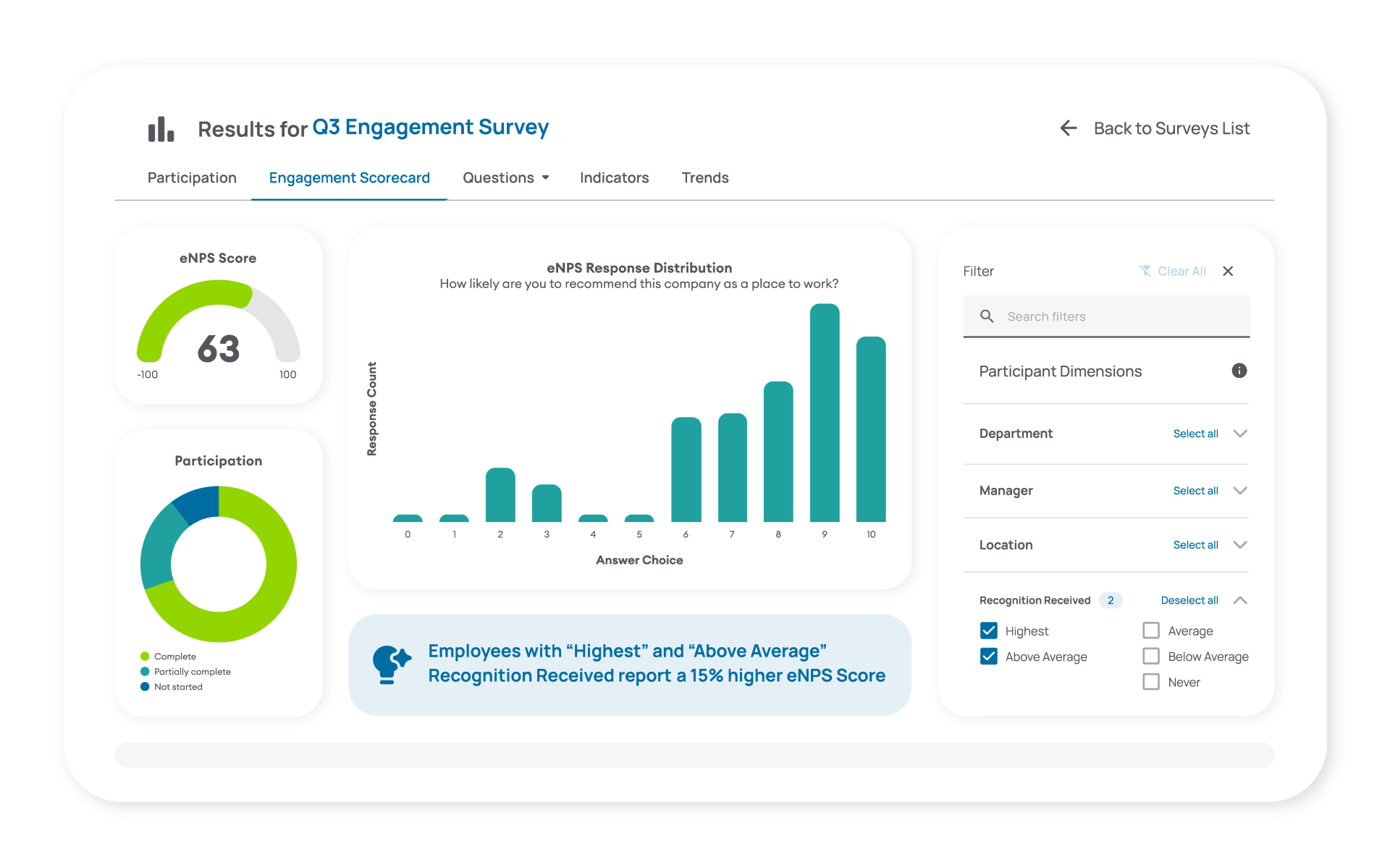 Combining these stats from employee listening, such as eNPS and engagement indicator scores, lets you answer questions around retention like:
Combining these stats from employee listening, such as eNPS and engagement indicator scores, lets you answer questions around retention like:
- Are the eNPS scores of our most recognized employees increasing?
- Is recognition positively impacting a sense of belonging?
- Do managers who participate in recognizing their employees have teams with higher eNPS scores?
These insights prove your program’s impact and reveal opportunities to improve employee engagement with more targeted, tailored programs. For example, let’s say teams that are most recognized by their managers show the highest eNPS scores and strong engagement indicator scores. You can use the data to convince leadership of manager recognition’s impact and launch a training program for leaders who need to participate more in the program.
Sometimes, your data might reveal organization-wide challenges that need to be addressed. One of our customers, Amteck, approached us about reviving a company-wide program after employee listening revealed most workers were disconnected from Amteck’s core values.
How Amteck Scaled Its Culture-Driven Retention Strategy with Terryberry

Amteck is a fast-growing, family-owned construction company that boasts strong retention rates in an industry marked by high turnover. Amteck’s core values shape the company’s people-first culture—the same culture that kept its workforce engaged, cultivated a sense of belonging, and helped retain people.
As Amteck’s workforce grew across 13 states, maintaining its strong culture and communicating core values became challenging. Matt Noble, Marketing and Communications Manager at Amteck, shares how people were losing their connection to the company’s core values:
"When we asked people about Amteck's core values, only 1 in 10 employees could articulate them correctly. This was a wake-up call, highlighting the need to show appreciation in ways that resonated and aligned with our core values."
The company’s leadership realized they needed to address this gap, but they faced several challenges along the way. Leaders struggled to communicate core values across the workforce, and to reach everyone equally. Previous recognition efforts either struggled because of fragmented data, or they’d been phased out entirely.
Amteck partnered with Terryberry to overcome these challenges and transform its employee recognition program with Custom Awards that reinforce the company’s core values across its large, distributed workforce.
As a result, Amteck saw a 65% increase in employees articulating core values within 3 months, and boasts an 85% retention rate among employees with over 10 years of service.
Here’s how we did it:
- Reviving Amteck’s legacy rings program to recognize people’s contributions and celebrate service milestones. Terryberry designed and manufactured custom rings for the program—employees can choose from traditional designs, modern styles, and a pendant option.
- Engaging leadership. Amteck’s executives and senior leaders personally distribute the rings, making each recognition moment special and keeping people connected to the company’s culture. Each recognition moment is documented through photos and videos and shared in the company's internal newsletter.
- Minimizing admin work. From managing employee data to tracking milestones and distributing the awards, Terryberry’s recognition platform automated key processes, saving Amteck’s team 70% of the administrative time previously spent on recognition programs.
2 Alternative Employee Recognition Software Examples
Interested in standalone employee recognition tools? Here are some Terryberry alternatives:
- Bonusly: Facilitates quick recognition by making it easy to automate employee awards and bonuses. Managers can award bonuses and choose from various reward options, such as gift cards and cash-out options, and schedule 1:1 meetings with employees to show appreciation.
While Bonusly is a good option for small teams looking to launch on-the-spot recognition, it has limited reporting capabilities and doesn’t include employee listening features. This means you can’t measure the impact of recognition on retention, and employee engagement in general.
- NectarHR: Offers employee recognition and rewards with internal communication features in one platform. You can launch peer recognition, manager recognition, and service award programs and choose from Nectar’s extensive catalog that includes swag, gift cards, and Amazon products.
The internal communication features let you design and distribute company announcements, schedule planning meetings, and analyze communication metrics (such as open and click-through rates). Like Bonusly, NectarHR lacks any robust employee listening features, making it difficult to measure the impact of your recognition program.
Read more: 8 Top Picks for the Best Employee Recognition Software
3. Fight Burnout with Employee Wellness Software
Prioritizing employee health reduces the stress people feel at work and cultivates a positive connection with your company’s culture, making them less likely to leave.
Studies reveal that as many as 42% of voluntary employee leaves were due to burnout or stress, and burned-out employees are twice as likely to look for a job elsewhere.
Many companies do realize the importance of employee wellness, but they struggle to tackle it effectively. They’ll launch well-meaning initiatives and get leadership buy-in, but managing these programs and encouraging participation remain challenging without the right tools. HR teams get bogged down with manual admin work, such as managing participation on spreadsheets and even using makeshift leadership boards. They lack real-time visibility into who is and isn’t participating, and they struggle to motivate people to engage.
For example, a Glassdoor study found that, even when companies offer unlimited PTO or more PTO than usual, employees may not take advantage of their time off. Clients we worked with previously launched wellness programs, like annual walking challenges, but struggled to get participation and activity numbers up.
Employee wellness platforms solve these challenges by automating the admin work, displaying centralized, real-time data, and providing tools to customize and gamify the programs.
Platforms like Terryberry let you launch, manage, and scale tailored programs that proactively address employee wellbeing. The goal is to create a culture and put systems in place that prevent burnout, rather than addressing it after the fact.
There’s another type of wellness platform that’s more focused on giving employees care, or gamifying wellness experiences, than building systems that complement your broader retention strategy. These tools are great at what they do, but proving their impact on retention can be challenging.
Below, we discuss how Terryberry’s wellness platform facilitates employee wellbeing and retention, and we cover some wellness apps with various support features.
Terryberry’s Employee Wellness Platform
Terryberry’s employee wellness platform lets you design and launch tailored wellness programs, gamify experiences, and reward people for participating.
The platform’s core capabilities include:
- Step and activity challenges. Launch custom challenges that encourage team building and improve people’s physical and mental wellbeing. Track steps, activity, and other wellness factors such as mood, activity, hydration, heart rate, and weight. Our easy-to-use activity converter keeps wellness programs inclusive by allowing people to choose how they move, making wellness accessible for all body types, abilities, and interests.
- Personalized wellbeing plans. Terryberry’s wellness platform offers wellbeing plans tailored to your team's specific needs, whether your goal is to reduce stress, encourage physical activity, or help people stay focused.
- Training and wellbeing webinars. Our expert-led trainings help teams foster and sustain mental well-being in the workplace. Tap into Terryberry’s wellness library that includes over 150 expert audio guides across 40+ mental health topics. Schedule annual 60-minute trainings that address specific challenges like workplace burnout or successfully managing work-life balance.
- Rewards. Terryberry’s extensive rewards catalog includes wellness gifts such as fitness trackers, yoga mats, standing desks, and even spa days. Our rewards platform integrates with Amazon Business, bringing Prime’s signature stress-free fulfillment experience to your employees—with zero markups.
Use Terryberry’s wellness analytics and reporting to track your program’s progress and make sure it’s fulfilling your intended goals. Track participation, progress, and granular insights about different teams.
Our wellness software is integrated with Terryberry’s broader employee engagement platform, making Terryberry the only engagement suite that measures how employee recognition, wellness, and listening impact each other.
These insights help you launch tailored programs and measure their impact. For example, let’s say your recognition analytics and engagement indicator scores reveal that your most recognized employees score the lowest in well-being. This indicates that your top performers may be burned out, launching a tailored well-being program can help address their specific challenges.
2 Alternative Employee Wellness Software Options
Interested in standalone wellness apps? Here are some popular choices:
- Headspace: Laser-focused on wellness, Headspace provides mindfulness tools, sleep support, on-demand mental health coaching, plus therapy and psychiatry services. If you’re looking for a provider that offers comprehensive employee care services, Headspace is worth considering.
Where retention is concerned, though, Headspace can fall short for two reasons: (1) it lacks employee feedback capabilities, and (2) its focus is on individual care rather than initiatives that engage teams. This means you might struggle to, say, cultivate a sense of belonging and inclusivity, which positively impacts employees’ wellbeing.
- YuMuuv: A standalone wellness challenge app that lets you design various challenges, including step, sleep, running, plank, car-free, and more. The app is easy to use and available in 37 languages, with niche features like an in-app chat that lets people share pictures.
You can also customize the app with your company’s branding and track people’s participation and progress with detailed analytics. While YuMuuv is a fun app for launching various challenges, its offering ends there.
Discover more wellness apps here: Top 10 Employee Wellness Software Solutions
4. Support Your Team with Learning & Development Platforms
Providing people with learning and career development opportunities keeps them engaged at work and creates more equitable experiences, ultimately boosting retention. Growing businesses may find it challenging to launch relevant and scalable development programs because:
- They lack expert-led guidance for specialized roles. Whether it’s sales enablement, compliance training, upskilling, or training for your frontline workforce, you’ll need experts to drive the initiatives and support people along the way.
- Delivering personalized, relevant learning experiences at scale involves lots of admin work. Do teams know what kind of training is available? Are the segments that need support (uncovered by employee listening) engaged in these programs? Are you measuring the impact of training initiatives on different teams?
Employee training software (also known as talent or learning management systems) solves these challenges with large repositories of expert-led courses and training content, which you can tailor to the needs of specific departments, teams, and individuals. Beyond content libraries, these tools offer various features to customize learning experiences, such as:
- Learning paths, where you define the steps that each learner goes through to progress.
- Gamification, with leaderboards, point systems, and rewards to encourage participation and healthy competition.
- Career planning. Design learning experiences that help people figure out their dream role for themselves, and give them the tools to grow into these positions over time.
Employee training software also automates the manual work involved in maintaining these programs. They integrate with your existing tech stack, so people can learn and track progress on their preferred channels. Analytics and reports are generated automatically, allowing administrators and learners to monitor real-time progress.
While you can choose from dozens of talent management systems, here are two popular platforms with proven experience in driving retention:
- TalentLMS: A dedicated corporate learning platform that supports various training and upskilling initiatives, including employee, compliance, sales, remote workforce training, and more. The platform’s library includes over 1000 pre-made courses, and you can design custom ones using AI features.
- Docebo: A genAI-first corporate LMS with a strong, experienced services team to support you in learning initiatives. The platform offers training and development programs for various use cases, including talent development, customer education, training for frontline workforces, and more.
Docebo also offers industry-specific learning experiences, from ecommerce to manufacturing and healthcare. Docebo boasts over 250 experts with an average of 11+ years in learning and development, ready to help you customize and scale your learning initiatives.
5. Performance Management Tools
While talent management systems provide people with training and upskilling opportunities, performance management tools are more niche-focused. They facilitate and simplify sharing feedback, performance reviews, and measuring people’s performance. The core features that support these goals include:
- Centralized, real-time talent performance data, empowering managers to share accurate and relevant feedback. Performance management tools also help managers spot challenges—like a salesperson missing their targets—before they become bottlenecks.
- Manager support. Give managers and team leads the tools and training they need to share feedback candidly and easily manage performance reviews. Empowering your managers to improve the performance management process gives employees a more positive experience. They’ll feel more seen, supported, and appreciated.
- Goal setting and performance paths. Various collaborative features, from OKRs to vision boards and “strengths discovery” features, help teams and managers outline responsibilities and career paths that motivate people to drive company goals.
Some vendors offer performance management tools as standalone offerings, while others integrate them with their broader HR suite (which may include modules for training, payroll, resource management, etc.).
Here are some leading providers to consider:
- 15Five: A standalone performance management platform that focuses on aligning managers and employees around shared objectives while tracking progress towards these goals. The platform lets you design custom learning paths, schedule and conduct performance reviews, and gives managers relevant insights to offer constructive and timely feedback.
15Five emphasizes the importance of training your managers and executives to empower their teams. The vendor offers on-demand training and live coaching to help people managers drive performance and reduce turnover.
- Personio: An integrated HR management software for small and medium-sized businesses. The vendor’s product suite includes tools for managing core HR processes, payroll, employee engagement, recruiting, and performance.
Personio’s performance management tool focuses on reducing the admin work involved in sharing performance feedback and analyzing your data. You can create personalized review cycles that suit everyone’s schedules, visualize data across performance cycles, and connect goals to performance and compensation.
Boost Employee Retention with Terryberry’s Integrated Employee Engagement Platform
When you’re trying to develop an impactful retention strategy, fragmented data is not your friend. To really understand the factors contributing to retention and attrition, and the sentiments of different groups, you’ll need to combine employee listening and engagement data.
Terryberry’s integrated employee engagement suite includes employee listening, recognition, and wellness platforms with centralized analytics. Uncover the factors impacting retention with employee listening, and launch tailored programs to tackle attrition. Measure the impact of employee recognition on eNPS and engagement, or how your wellness program impacts detractors, promoters, and top performers.
Schedule a demo with Terryberry to launch your end-to-end employee retention strategy.
